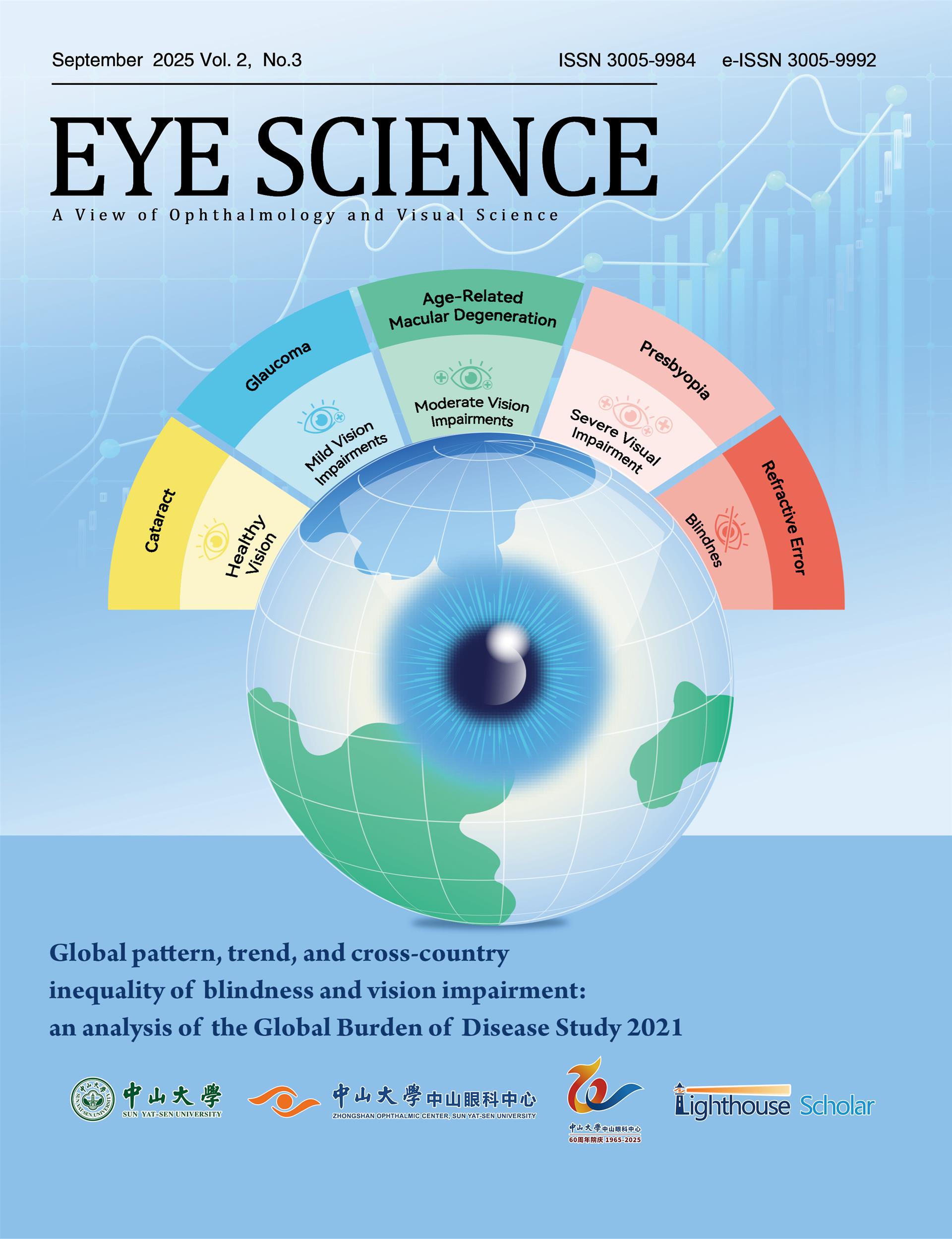1、World Health Organization. Blindness and Vision
Impairment. August 10, 2023. Accessed February 7, 2025.
https://www.who.int/en/news-room/fact-sheets/detail/
blindness-and-visual-impairment.World Health Organization. Blindness and Vision
Impairment. August 10, 2023. Accessed February 7, 2025.
https://www.who.int/en/news-room/fact-sheets/detail/
blindness-and-visual-impairment.
2、Holden BA, Fricke TR, Wilson DA, et al. Global
prevalence of myopia and high myopia and temporal
trends from 2000 through 2050. Ophthalmology. 2016,
123(5): 1036-1042. DOI: 10.1016/j.ophtha.2016.01.006.Holden BA, Fricke TR, Wilson DA, et al. Global
prevalence of myopia and high myopia and temporal
trends from 2000 through 2050. Ophthalmology. 2016,
123(5): 1036-1042. DOI: 10.1016/j.ophtha.2016.01.006.
3、Li M, Xu L, Tan CS, et al. Systematic review and meta�analysis on the impact of COVID-19 pandemic-related lifestyle on myopia. Asia Pac J Ophthalmol (Phila). 2022,
11(5): 470-480. DOI: 10.1097/APO.0000000000000559.Li M, Xu L, Tan CS, et al. Systematic review and meta�analysis on the impact of COVID-19 pandemic-related lifestyle on myopia. Asia Pac J Ophthalmol (Phila). 2022,
11(5): 470-480. DOI: 10.1097/APO.0000000000000559.
4、World Health Organization. Social Determinant of Health.
Accessed February 7, 2025. https://www.who.int/health�topics/social-determinants-of-health.World Health Organization. Social Determinant of Health.
Accessed February 7, 2025. https://www.who.int/health�topics/social-determinants-of-health.
5、Zhang X, Elliott MN, Saaddine JB, et al. Unmet eye care
needs among U.S. 5th-grade students. Am J Prev Med.
2012, 43(1): 55-58. DOI: 10.1016/j.amepre.2012.01.032.Zhang X, Elliott MN, Saaddine JB, et al. Unmet eye care
needs among U.S. 5th-grade students. Am J Prev Med.
2012, 43(1): 55-58. DOI: 10.1016/j.amepre.2012.01.032.
6、Keel S, Mueller A. WHO SPECS 2030 - a global initiative
to strengthen refractive error care. Community Eye Health.
2024, 37(122): 6-7.Keel S, Mueller A. WHO SPECS 2030 - a global initiative
to strengthen refractive error care. Community Eye Health.
2024, 37(122): 6-7.
7、Wu PC, Tsai CL, Wu HL, et al. Outdoor activity during
class recess reduces myopia onset and progression in
school children. Ophthalmology. 2013, 120(5): 1080-1085.
DOI: 10.1016/j.ophtha.2012.11.009.Wu PC, Tsai CL, Wu HL, et al. Outdoor activity during
class recess reduces myopia onset and progression in
school children. Ophthalmology. 2013, 120(5): 1080-1085.
DOI: 10.1016/j.ophtha.2012.11.009.
8、He M, Xiang F, Zeng Y, et al. Effect of time spent outdoors
at school on the development of myopia among children in
China: a randomized clinical trial. JAMA. 2015, 314(11):
1142-1148. DOI: 10.1001/jama.2015.10803.He M, Xiang F, Zeng Y, et al. Effect of time spent outdoors
at school on the development of myopia among children in
China: a randomized clinical trial. JAMA. 2015, 314(11):
1142-1148. DOI: 10.1001/jama.2015.10803.
9、Ethan D, Basch CE, Platt R, et al. Implementing and
evaluating a school-based program to improve childhood
vision. J Sch Health. 2010, 80(7): 340-345;quiz 368-370.
DOI: 10.1111/j.1746-1561.2010.00511.x.Ethan D, Basch CE, Platt R, et al. Implementing and
evaluating a school-based program to improve childhood
vision. J Sch Health. 2010, 80(7): 340-345;quiz 368-370.
DOI: 10.1111/j.1746-1561.2010.00511.x.
10、Ying GS, Maguire MG, Cyert LA, et al. Prevalence of
vision disorders by racial and ethnic group among children
participating in head start. Ophthalmology. 2014, 121(3):
630-636. DOI: 10.1016/j.ophtha.2013.09.036.Ying GS, Maguire MG, Cyert LA, et al. Prevalence of
vision disorders by racial and ethnic group among children
participating in head start. Ophthalmology. 2014, 121(3):
630-636. DOI: 10.1016/j.ophtha.2013.09.036.
11、Dotan G, Truong B, Snitzer M, et al. Outcomes of an
inner-city vision outreach program: give kids sight day.
JAMA Ophthalmol. 2015, 133(5): 527-532. DOI: 10.1001/
jamaophthalmol.2015.8.Dotan G, Truong B, Snitzer M, et al. Outcomes of an
inner-city vision outreach program: give kids sight day.
JAMA Ophthalmol. 2015, 133(5): 527-532. DOI: 10.1001/
jamaophthalmol.2015.8.
12、Killeen OJ, Zhou Y, Musch DC, et al. Access to eye care
and prevalence of refractive error and eye conditions at a
high school-based eye clinic in southeastern Michigan. J
AAPOS. 2022, 26(4): 185.e1-185185.e6. DOI: 10.1016/
j.jaapos.2022.04.009.Killeen OJ, Zhou Y, Musch DC, et al. Access to eye care
and prevalence of refractive error and eye conditions at a
high school-based eye clinic in southeastern Michigan. J
AAPOS. 2022, 26(4): 185.e1-185185.e6. DOI: 10.1016/
j.jaapos.2022.04.009.
13、Lee KE, Sussberg JA, Nelson LB, et al. Review of the
disparities in access to pediatric eye care among low
socioeconomic status and underrepresented racial minority
groups exacerbated by the economic downturn in pediatric
ophthalmology. J Pediatr Ophthalmol Strabismus. 2024,
61(3): 172-178. DOI: 10.3928/01913913-20231026-05.Lee KE, Sussberg JA, Nelson LB, et al. Review of the
disparities in access to pediatric eye care among low
socioeconomic status and underrepresented racial minority
groups exacerbated by the economic downturn in pediatric
ophthalmology. J Pediatr Ophthalmol Strabismus. 2024,
61(3): 172-178. DOI: 10.3928/01913913-20231026-05.
14、Chauhan MZ, Elhusseiny AM, Rook BS, et al.
Socioeconomic and racial disparities in vision care
access and impairment among United States children.
Ophthalmology. 2023, 130(7): 772-775. DOI: 10.1016/
j.ophtha.2023.02.019.Chauhan MZ, Elhusseiny AM, Rook BS, et al.
Socioeconomic and racial disparities in vision care
access and impairment among United States children.
Ophthalmology. 2023, 130(7): 772-775. DOI: 10.1016/
j.ophtha.2023.02.019.
15、Adomfeh J, Jastrzembski BG, Oke I. Association of race, ethnicity, and socioeconomic status with visual
impairment in adolescent children in the US. JAMA
Ophthalmol. 2022, 140(10): 1006-1010. DOI: 10.1001/
jamaophthalmol.2022.3627.Adomfeh J, Jastrzembski BG, Oke I. Association of race, ethnicity, and socioeconomic status with visual
impairment in adolescent children in the US. JAMA
Ophthalmol. 2022, 140(10): 1006-1010. DOI: 10.1001/
jamaophthalmol.2022.3627.
16、Oke I, Slopen N, Hunter DG, et al. Vision testing for
adolescents in the US. JAMA Ophthalmol. 2023, 141(11):
1068-1072. DOI: 10.1001/jamaophthalmol.2023.4475.Oke I, Slopen N, Hunter DG, et al. Vision testing for
adolescents in the US. JAMA Ophthalmol. 2023, 141(11):
1068-1072. DOI: 10.1001/jamaophthalmol.2023.4475.
17、Antonio-Aguirre B, Block SS, Asare AO, et al. Association
of sociodemographic characteristics with pediatric vision
screening and eye care: an analysis of the 2021 national
survey of children’s health. Ophthalmology. 2024, 131(5):
611-621. DOI: 10.1016/j.ophtha.2023.12.005.Antonio-Aguirre B, Block SS, Asare AO, et al. Association
of sociodemographic characteristics with pediatric vision
screening and eye care: an analysis of the 2021 national
survey of children’s health. Ophthalmology. 2024, 131(5):
611-621. DOI: 10.1016/j.ophtha.2023.12.005.
18、Asare AO, Stagg BC, Stipelman C, et al. Access to vision
care for children from immigrant and nonimmigrant
households: evidence from the National Survey of
Children’s Health 2018-2019. J AAPOS. 2024, 28(6):
104044. DOI: 10.1016/j.jaapos.2024.104044.Asare AO, Stagg BC, Stipelman C, et al. Access to vision
care for children from immigrant and nonimmigrant
households: evidence from the National Survey of
Children’s Health 2018-2019. J AAPOS. 2024, 28(6):
104044. DOI: 10.1016/j.jaapos.2024.104044.
19、Kim AB, Cheng BT. Association of household language
and vision screening among children in the United
States. J AAPOS. 2024, 28(2): 103858. DOI: 10.1016/
j.jaapos.2024.103858.Kim AB, Cheng BT. Association of household language
and vision screening among children in the United
States. J AAPOS. 2024, 28(2): 103858. DOI: 10.1016/
j.jaapos.2024.103858.
20、Oke I, Slopen N, Galbraith AA, et al. Gaps in the vision
screening pathway for school-aged US children. JAMA
Ophthalmol. 2024, 142(3): 268-270. DOI: 10.1001/
jamaophthalmol.2023.6316.Oke I, Slopen N, Galbraith AA, et al. Gaps in the vision
screening pathway for school-aged US children. JAMA
Ophthalmol. 2024, 142(3): 268-270. DOI: 10.1001/
jamaophthalmol.2023.6316.
21、US Department of Health and Human Services. Healthy
People 2030. Accessed February 7, 2025. https://odphp.
health.gov/healthypeople.US Department of Health and Human Services. Healthy
People 2030. Accessed February 7, 2025. https://odphp.
health.gov/healthypeople.
22、Elam AR, Tseng VL, Rodriguez TM, et al. Disparities in
vision health and eye care. Ophthalmology. 2022, 129(10):
e89-e113. DOI: 10.1016/j.ophtha.2022.07.010.Elam AR, Tseng VL, Rodriguez TM, et al. Disparities in
vision health and eye care. Ophthalmology. 2022, 129(10):
e89-e113. DOI: 10.1016/j.ophtha.2022.07.010.
23、Ervin AM, Solomon SD, Shoge RY. Access to eye care
in the United States: evidence-informed decision-making
is key to improving access for underserved populations.
Ophthalmology. 2022, 129(10): 1079-1080. DOI: 10.1016/
j.ophtha.2022.07.011.Ervin AM, Solomon SD, Shoge RY. Access to eye care
in the United States: evidence-informed decision-making
is key to improving access for underserved populations.
Ophthalmology. 2022, 129(10): 1079-1080. DOI: 10.1016/
j.ophtha.2022.07.011.
24、Alvi RA, Justason L, Liotta C, et al. The Eagles Eye
Mobile: assessing its ability to deliver eye care in a high�risk community. J Pediatr Ophthalmol Strabismus. 2015,
52(2): 98-105. DOI: 10.3928/01913913-20150216-02.Alvi RA, Justason L, Liotta C, et al. The Eagles Eye
Mobile: assessing its ability to deliver eye care in a high�risk community. J Pediatr Ophthalmol Strabismus. 2015,
52(2): 98-105. DOI: 10.3928/01913913-20150216-02.
25、Griffith JF, Wilson R, Cimino HC, et al. The use of a
mobile van for school vision screening: results of 63 841
evaluations. Am J Ophthalmol. 2016, 163: 108-114.e1.
DOI: 10.1016/j.ajo.2015.11.026.Griffith JF, Wilson R, Cimino HC, et al. The use of a
mobile van for school vision screening: results of 63 841
evaluations. Am J Ophthalmol. 2016, 163: 108-114.e1.
DOI: 10.1016/j.ajo.2015.11.026.
26、Collins ME, Guo X, Repka MX, et al. Lessons learned
from school-based delivery of vision care in Baltimore,
Maryland. Asia Pac J Ophthalmol (Phila), 2022, 11(1):
6-11. DOI: 10.1097/APO.0000000000000488.Collins ME, Guo X, Repka MX, et al. Lessons learned
from school-based delivery of vision care in Baltimore,
Maryland. Asia Pac J Ophthalmol (Phila), 2022, 11(1):
6-11. DOI: 10.1097/APO.0000000000000488.
27、Ma X, Wang H, Shi Y, et al. Improving learning by
improving vision: evidence from two randomized
controlled trials of providing vision care in China. J
Dev Eff. 2021, 13(1): 1-26. DOI: 10.1080/19439342.
2021.1876139.Ma X, Wang H, Shi Y, et al. Improving learning by
improving vision: evidence from two randomized
controlled trials of providing vision care in China. J
Dev Eff. 2021, 13(1): 1-26. DOI: 10.1080/19439342.
2021.1876139.
28、Neitzel AJ, Wolf B, Guo X, et al. Effect of a randomized
interventional school-based vision program on academic
performance of students in grades 3 to 7: a cluster
randomized clinical trial. JAMA Ophthalmol. 2021,
139(10): 1104-1114. DOI: 10.1001/jamaophthalmol.
2021.3544.Neitzel AJ, Wolf B, Guo X, et al. Effect of a randomized
interventional school-based vision program on academic
performance of students in grades 3 to 7: a cluster
randomized clinical trial. JAMA Ophthalmol. 2021,
139(10): 1104-1114. DOI: 10.1001/jamaophthalmol.
2021.3544.
29、Glewwe P, West KL, Lee J. The impact of providing vision
screening and free eyeglasses on academic outcomes:
evidence from a randomized trial in title I elementary
schools in Florida. J Policy Anal Manage. 2018, 37(2):
265-300. DOI: 10.1002/pam.22043.Glewwe P, West KL, Lee J. The impact of providing vision
screening and free eyeglasses on academic outcomes:
evidence from a randomized trial in title I elementary
schools in Florida. J Policy Anal Manage. 2018, 37(2):
265-300. DOI: 10.1002/pam.22043.
30、Li D, Chan VF, Virgili G, et al. Impact of vision
impairment and ocular morbidity and their treatment
on quality of life in children: a systematic review.
Ophthalmology. 2024, 131(2): 188-207. DOI: 10.1016/
j.ophtha.2023.09.005.Li D, Chan VF, Virgili G, et al. Impact of vision
impairment and ocular morbidity and their treatment
on quality of life in children: a systematic review.
Ophthalmology. 2024, 131(2): 188-207. DOI: 10.1016/
j.ophtha.2023.09.005.
31、Li D, Chan VF, Virgili G, et al. Impact of vision
impairment and ocular morbidity and their treatment on
depression and anxiety in children: a systematic review.
Ophthalmology. 2022, 129(10): 1152-1170. DOI: 10.1016/
j.ophtha.2022.05.020.Li D, Chan VF, Virgili G, et al. Impact of vision
impairment and ocular morbidity and their treatment on
depression and anxiety in children: a systematic review.
Ophthalmology. 2022, 129(10): 1152-1170. DOI: 10.1016/
j.ophtha.2022.05.020.
32、Ambrosino CM, Callan J, Wiggins TMS, et al.
Considerations in building a school-based vision
program. J Sch Nurs. 2024, 40(5): 574-583. DOI:
10.1177/10598405231163753.Ambrosino CM, Callan J, Wiggins TMS, et al.
Considerations in building a school-based vision
program. J Sch Nurs. 2024, 40(5): 574-583. DOI:
10.1177/10598405231163753.
33、Rahmeh S, Kallem M, Guo X, Collins M. Landscape
Analysis of School-Based Vision Program Operations
in the Us: A Survey Study. AAPOS 2024 49TH Annual
Meeting; 2024; Austin, Texas.Rahmeh S, Kallem M, Guo X, Collins M. Landscape
Analysis of School-Based Vision Program Operations
in the Us: A Survey Study. AAPOS 2024 49TH Annual
Meeting; 2024; Austin, Texas.
34、United%20States%20Census%20Bureau.%20Baltimore%20city%2C%20Maryland.%20%0AAccessed%20February%207%2C%202025.%20https%3A%2F%2Fdata.census.gov%2Fprofile%2F%0ABaltimore_city%2C_Maryland%3Fg%3D050XX00US24510.United%20States%20Census%20Bureau.%20Baltimore%20city%2C%20Maryland.%20%0AAccessed%20February%207%2C%202025.%20https%3A%2F%2Fdata.census.gov%2Fprofile%2F%0ABaltimore_city%2C_Maryland%3Fg%3D050XX00US24510.
35、Baltimore City Public Schools. City Schools at a
Glance. Accessed February 7, 2025. https://www.
baltimorecityschools.org/page/district-overview/.Baltimore City Public Schools. City Schools at a
Glance. Accessed February 7, 2025. https://www.
baltimorecityschools.org/page/district-overview/.
36、Milante RR, Guo X, Neitzel AJ, et al. Analysis of vision
screening failures in a school-based vision program (2016-
19). J AAPOS. 2021, 25(1): 29.e1-29.29.e7. DOI: 10.1016/
j.jaapos.2020.09.006.Milante RR, Guo X, Neitzel AJ, et al. Analysis of vision
screening failures in a school-based vision program (2016-
19). J AAPOS. 2021, 25(1): 29.e1-29.29.e7. DOI: 10.1016/
j.jaapos.2020.09.006.
37、Vision for Baltimore. Accessed February 7, 2025. https://
visionforbaltimore.org/.Vision for Baltimore. Accessed February 7, 2025. https://
visionforbaltimore.org/.
38、Nguyen AM, Guo X, Dai XD, et al. Refractive profiles
in children receiving school-based eye exams following vision screening from a large school-based vision program
in 2016 to 2022. Ophthalmic Epidemiol. 2024: 1-9. DOI:
10.1080/09286586.2024.2422351.Nguyen AM, Guo X, Dai XD, et al. Refractive profiles
in children receiving school-based eye exams following vision screening from a large school-based vision program
in 2016 to 2022. Ophthalmic Epidemiol. 2024: 1-9. DOI:
10.1080/09286586.2024.2422351.
39、Pizzarello L, Tilp M, Tiezzi L, et al. A new school-based
program to provide eyeglasses: childsight. J AAPOS. 1998,
2(6): 372-374. DOI: 10.1016/s1091-8531(98)90038-6.Pizzarello L, Tilp M, Tiezzi L, et al. A new school-based
program to provide eyeglasses: childsight. J AAPOS. 1998,
2(6): 372-374. DOI: 10.1016/s1091-8531(98)90038-6.
40、Bodack MI, Chung I, Krumholtz I. An analysis of vision
screening data from New York City public schools.
Optometry. 2010, 81(9): 476-484. DOI: 10.1016/j.optm.
2010.05.006.Bodack MI, Chung I, Krumholtz I. An analysis of vision
screening data from New York City public schools.
Optometry. 2010, 81(9): 476-484. DOI: 10.1016/j.optm.
2010.05.006.
41、Guo X, Nguyen AM, Vongsachang H, et al. Refractive
error findings in students who failed school-based vision
screening. Ophthalmic Epidemiol. 2022, 29(4): 426-434.
DOI: 10.1080/09286586.2021.1954664.Guo X, Nguyen AM, Vongsachang H, et al. Refractive
error findings in students who failed school-based vision
screening. Ophthalmic Epidemiol. 2022, 29(4): 426-434.
DOI: 10.1080/09286586.2021.1954664.
42、Guo X, Friedman DS, Repka MX, et al. Visual acuity and
refractive findings in children prescribed glasses from a
school-based vision program. J AAPOS. 2021, 25(6): 344.
e1-344344.e7. DOI: 10.1016/j.jaapos.2021.07.013.Guo X, Friedman DS, Repka MX, et al. Visual acuity and
refractive findings in children prescribed glasses from a
school-based vision program. J AAPOS. 2021, 25(6): 344.
e1-344344.e7. DOI: 10.1016/j.jaapos.2021.07.013.
43、Hendler K, Mehravaran S, Lu X, et al. Refractive errors
and amblyopia in the UCLA preschool vision program;
first year results. Am J Ophthalmol. 2016, 172: 80-86.
DOI: 10.1016/j.ajo.2016.09.010.Hendler K, Mehravaran S, Lu X, et al. Refractive errors
and amblyopia in the UCLA preschool vision program;
first year results. Am J Ophthalmol. 2016, 172: 80-86.
DOI: 10.1016/j.ajo.2016.09.010.
44、Ambrosino CM, Collins ME, Nguyen A, et al. Need for
eyeglasses and prescription updates in students receiving
a school-based eye exam. Optom Vis Sci. 2025. DOI:
10.1097/opx.0000000000002251.Ambrosino CM, Collins ME, Nguyen A, et al. Need for
eyeglasses and prescription updates in students receiving
a school-based eye exam. Optom Vis Sci. 2025. DOI:
10.1097/opx.0000000000002251.
45、Kallem M, Guo X, Dai X, et al. Associations between
school-based vision program outcomes and school
characteristics in 410 schools. Ophthalmology. 2025,
132(4): 452-460. DOI: 10.1016/j.ophtha.2024.11.012.Kallem M, Guo X, Dai X, et al. Associations between
school-based vision program outcomes and school
characteristics in 410 schools. Ophthalmology. 2025,
132(4): 452-460. DOI: 10.1016/j.ophtha.2024.11.012.
46、Shakarchi AF, Guo X, Friedman DS, et al. Vision needs
of children who failed school-based vision screening with
and without eyeglasses. Ophthalmic Epidemiol. 2021,
28(2): 131-137. DOI: 10.1080/09286586.2020.1800754.Shakarchi AF, Guo X, Friedman DS, et al. Vision needs
of children who failed school-based vision screening with
and without eyeglasses. Ophthalmic Epidemiol. 2021,
28(2): 131-137. DOI: 10.1080/09286586.2020.1800754.
47、Ambrosino CM, Guo X, Nguyen A, et al. Practices of a
United States school-based vision program in referring
children to community eye care. J AAPOS. 2025, 29(2):
104164. DOI: 10.1016/j.jaapos.2025.104164.Ambrosino CM, Guo X, Nguyen A, et al. Practices of a
United States school-based vision program in referring
children to community eye care. J AAPOS. 2025, 29(2):
104164. DOI: 10.1016/j.jaapos.2025.104164.
48、Chauhan MZ, Elhusseiny AM, Samarah ES, et al. Five�year trends in pediatric vision screening and access in the
United States. Ophthalmology. 2023, 130(1): 120-122.
DOI: 10.1016/j.ophtha.2022.09.018.Chauhan MZ, Elhusseiny AM, Samarah ES, et al. Five�year trends in pediatric vision screening and access in the
United States. Ophthalmology. 2023, 130(1): 120-122.
DOI: 10.1016/j.ophtha.2022.09.018.
49、Walsh HL, Parrish A, Hucko L, et al. Access to pediatric
ophthalmological care by geographic distribution and US
population demographic characteristics in 2022. JAMA
Ophthalmol. 2023, 141(3): 242-249. DOI: 10.1001/
jamaophthalmol.2022.6010.Walsh HL, Parrish A, Hucko L, et al. Access to pediatric
ophthalmological care by geographic distribution and US
population demographic characteristics in 2022. JAMA
Ophthalmol. 2023, 141(3): 242-249. DOI: 10.1001/
jamaophthalmol.2022.6010.
50、Lee KE, Sussberg JA, Nelson LB, et al. The Medicaid dilemma and its profound effect on the economic
and workforce issues in pediatric ophthalmology and
ultimately on access to pediatric eye care. J Pediatr
Ophthalmol Strabismus. 2023, 60(3): 170-177. DOI:
10.3928/01913913-20230314-01.Lee KE, Sussberg JA, Nelson LB, et al. The Medicaid dilemma and its profound effect on the economic
and workforce issues in pediatric ophthalmology and
ultimately on access to pediatric eye care. J Pediatr
Ophthalmol Strabismus. 2023, 60(3): 170-177. DOI:
10.3928/01913913-20230314-01.
51、Collins ME, Antonio-Aguirre B. Bridging the gap
in adolescent vision care through schools. JAMA
Ophthalmol. 2023, 141(11): 1073-1074. DOI: 10.1001/
jamaophthalmol.2023.4702.Collins ME, Antonio-Aguirre B. Bridging the gap
in adolescent vision care through schools. JAMA
Ophthalmol. 2023, 141(11): 1073-1074. DOI: 10.1001/
jamaophthalmol.2023.4702.
52、Ambrosino C, Repka MX, Collins MLZ, et al. Advancing
health equity in pediatric eye care: the role of school�based vision programs, research, advocacy, community
engagement, and medical education. J Am Assoc Pediatr
Ophthalmol Strabismus. 2023, 27(2): 70-74. DOI:
10.1016/j.jaapos.2022.11.022.Ambrosino C, Repka MX, Collins MLZ, et al. Advancing
health equity in pediatric eye care: the role of school�based vision programs, research, advocacy, community
engagement, and medical education. J Am Assoc Pediatr
Ophthalmol Strabismus. 2023, 27(2): 70-74. DOI:
10.1016/j.jaapos.2022.11.022.
53、Antonio-Aguirre B, Ambrosino CM, Dai X, et al.
Addressing health disparities in pediatric eye care for
school-age children: a call to action. Transl Vis Sci
Technol. 2023, 12(11): 17. DOI: 10.1167/tvst.12.11.17.Antonio-Aguirre B, Ambrosino CM, Dai X, et al.
Addressing health disparities in pediatric eye care for
school-age children: a call to action. Transl Vis Sci
Technol. 2023, 12(11): 17. DOI: 10.1167/tvst.12.11.17.
54、Vongsachang H, Callan J, Kretz AM, et al. Teacher and
school staff perspectives on their role in school-based
vision programs. Can J Ophthalmol. 2022, 57(6): 381-387.
DOI: 10.1016/j.jcjo.2021.06.011.Vongsachang H, Callan J, Kretz AM, et al. Teacher and
school staff perspectives on their role in school-based
vision programs. Can J Ophthalmol. 2022, 57(6): 381-387.
DOI: 10.1016/j.jcjo.2021.06.011.
55、Kretz AM, Vongsachang H, Friedman DS, et al.
Stakeholders' perceptions of a school-based eye care
programme in Baltimore, MD. Ophthalmic Epidemiol.
2022, 29(3): 252-261. DOI: 10.1080/09286586.
2021.1946825.Kretz AM, Vongsachang H, Friedman DS, et al.
Stakeholders' perceptions of a school-based eye care
programme in Baltimore, MD. Ophthalmic Epidemiol.
2022, 29(3): 252-261. DOI: 10.1080/09286586.
2021.1946825.
56、Given H, Neitzel A, Shakarchi A, et al. School-level
factors and consent form return rate in a school-based
vision program. Health Behav Policy Rev. 2021, 8(2): 148-
158. DOI: 10.14485/hbpr.8.2.5.Given H, Neitzel A, Shakarchi A, et al. School-level
factors and consent form return rate in a school-based
vision program. Health Behav Policy Rev. 2021, 8(2): 148-
158. DOI: 10.14485/hbpr.8.2.5.
57、Shakarchi AF, Collins ME. Referral to community care
from school-based eye care programs in the United States.
Surv Ophthalmol. 2019, 64(6): 858-867. DOI: 10.1016/
j.survophthal.2019.04.003.Shakarchi AF, Collins ME. Referral to community care
from school-based eye care programs in the United States.
Surv Ophthalmol. 2019, 64(6): 858-867. DOI: 10.1016/
j.survophthal.2019.04.003.
58、Killeen OJ, Lee PP. Broadening access to eyeglasses in
the US. JAMA Health Forum. 2022, 3(3): e215236. DOI:
10.1001/jamahealthforum.2021.5236.Killeen OJ, Lee PP. Broadening access to eyeglasses in
the US. JAMA Health Forum. 2022, 3(3): e215236. DOI:
10.1001/jamahealthforum.2021.5236.
59、Messer DH, Lynn Mitchell G, Daniel Twelker J, et al.
Spectacle wear in children given spectacles through a
school-based program. Optom Vis Sci. 2012, 89(1): 19-26.
DOI: 10.1097/OPX.0b013e3182357f8c.Messer DH, Lynn Mitchell G, Daniel Twelker J, et al.
Spectacle wear in children given spectacles through a
school-based program. Optom Vis Sci. 2012, 89(1): 19-26.
DOI: 10.1097/OPX.0b013e3182357f8c.
60、Varma R, Tarczy-Hornoch K, Jiang X. Visual impairment
in preschool children in the United States: demographic
and geographic variations from 2015 to 2060. JAMA
Ophthalmol. 2017, 135(6): 610-616. DOI: 10.1001/
jamaophthalmol.2017.1021.Varma R, Tarczy-Hornoch K, Jiang X. Visual impairment
in preschool children in the United States: demographic
and geographic variations from 2015 to 2060. JAMA
Ophthalmol. 2017, 135(6): 610-616. DOI: 10.1001/
jamaophthalmol.2017.1021.


























